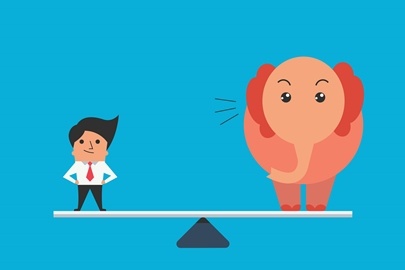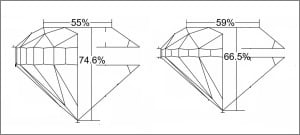
Carat weight is likely to be the 4C in which most customers are more familiar. It is also the easiest characteristic to describe and present to your customers since size differences are more easily discernible. Furthermore, carat weight plays an important part in the overall value of a diamond because larger diamonds are more rare and therefore cost more. However, just because a diamond might be bigger, does not necessarily mean it will be the best choice for your customer.
Overall diamond quality is determined by all of the 4Cs combined, and diamond jewelers should make it clear to their customers that larger diamonds can magnify cut, color and clarity for the better and sometimes for the worse. As a diamond retailer, describing the pros and cons of a larger diamond, based on that particular diamond’s combined characteristics, will allow your customer to determine which qualities are most important to them and if that particular diamond is what they are looking for.
Defining Carat Weight
The term “carat” is the standard unit of weight for diamonds and other gemstones. The name originates from the carob seed, which was the original unit of measure for diamond traders. In 1913 the United States implemented the modern metric carat, which is equal to 0.2 grams, and other countries soon followed. Today, a carat means the same thing everywhere in the world.
A carat can be further divided into 100 points, allowing for very precise measurements. This is critical for jewelers as even a very small weight difference can have an impact on the overall diamond value and pricing structure.
Diamond Carat Size Comparison
Just as two people, one who is tall and thin and the other who is short and stout, might weigh the same on the bathroom scale, two diamonds that appear to be different sizes might actually have the same carat weight. That’s because variations in shape and cut make diamonds of similar weights look different. Since carat weight is distributed over the entire diamond, other measurements are needed to describe the overall size:
Crown Area – this is the total surface area of the top of the diamond (measured in mm2). It shows the size of the diamond as it appears face up, similar to how we view a diamond when set in a ring.
 Cut Proportions – if two diamonds are the same carat weight and shape, but one carries a larger percentage of its weight in its depth, then the table percentage (flat section at the top of the diamond) and overall crown area will be smaller, giving the impression that the diamond is smaller from the top. The photo (right) shows two 1 ct. round diamonds, but the diamond on the left is cut deeper and therefore has a smaller table percentage across the top.
Cut Proportions – if two diamonds are the same carat weight and shape, but one carries a larger percentage of its weight in its depth, then the table percentage (flat section at the top of the diamond) and overall crown area will be smaller, giving the impression that the diamond is smaller from the top. The photo (right) shows two 1 ct. round diamonds, but the diamond on the left is cut deeper and therefore has a smaller table percentage across the top.
Shape – diamond shapes such as oval or marquise have elongated lengths, resulting in the appearance of a larger size per carat weight. Sometimes this size difference can be real, however, it can also be just an illusion based on perception.

It is important to explain to your customers how these different factors affect the perception of diamond size. A diamond with a higher carat weight is likely to be more expensive, but may not look that much larger than a smaller carat weight diamond once set in jewelry. Help your customer find a diamond that gives the largest perception of size for the jewelry setting they like, while staying within their budget.
Carat Weight, Rarity, and Pricing
The larger a diamond is, the more rare it is, so as the carat weight of a diamond increases, the diamond's price can also increase exponentially. In addition, diamond prices jump at the full-and half-carat weights. Not only is there an overall price hike, but as the carat weight increases, the price-per-carat climbs as well. Diamonds just below these cut-offs cost considerably less, and, because carat weight is distributed across the whole diamond, small size differences can be difficult to detect.
Before buying or selling any diamonds, always check that you are getting or setting the right price. The Rapaport Price List, the industry’s primary source for diamond price information, shows exactly how much a diamond should cost based on size, shape, color, clarity and cut. RapNet, the leading online diamond trading network, lists actual asking prices of diamonds being traded on a daily basis.
Conclusion
It is important for your customers to understand that carat is a measure of weight and not the physical size that the eye sees. Carat weight can have a large impact on a diamond’s value and for some customers this will be an important factor. However, for others, what really matters is the size a diamond appears to be from the top, once set in jewelry.
As small changes in carat weight can have little impact on the overall size appearance of a diamond, but yet still impact the price, you should guide your customers to find the right cut and setting to reflect the desired diamond size within their budget.


 RapNet Blog
RapNet Blog





